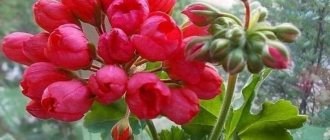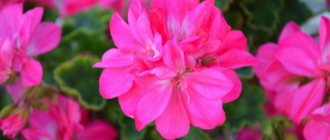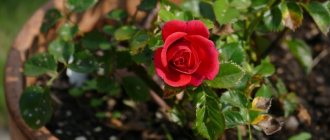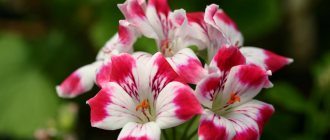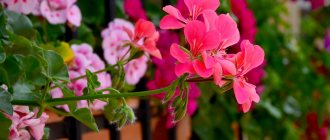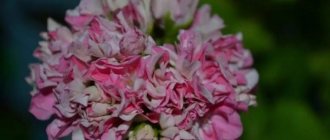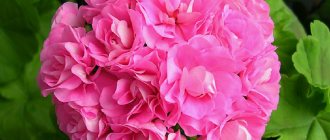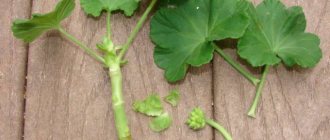A natural fragrance that grows on the windowsill and is always near you (and not somewhere in the store) is a dream that, thanks to fragrant pelargoniums, is coming true! The leaves of such pelargoniums are incredibly fragrant: just touch it and the aroma fills the room! When touched or rubbed, the leaves release an aroma similar to rose, apple, cinnamon, mint, lemon, orange, pineapple, peach, lavender, verbena, wormwood, pine, lily of the valley, ginger, juniper, cedar, almond, coconut, nutmeg, caramel, and sometimes have complex aromas (the aroma of balm, cologne, mossy forest, and even Coca-Cola drink!). Fragrant pelargonium (Pelargonium fragrans) has the smell of nutmeg, and most fragrant pelargonium (Pelargonium odoratissimum) has the smell of apple. If you collect dried flowers in glass vessels, you can create a whole collection of scents. Graveolens.
The flowers of fragrant pelargoniums are inferior in beauty to species and hybrid pelargoniums; they are usually small and dim, but some bloom elegantly due to the abundance of small flowers. Some pelargoniums hardly bloom on windowsills and are grown exclusively for their fragrant foliage. Moreover, their foliage can be unusual in shape, “curly”, and interesting.
The homeland of most fragrant pelargoniums is South Africa.
The essential oil of these plants varies greatly in composition and smell, even within the same species.
that smell like roses, mint and citruses are suitable for flavoring teas, drinks, and dishes
. Dried leaves are used and mixed with tea. Citrus-scented leaves can be used to season fish dishes and flavor vinegars and oils for salad dressings.
Geranium essential oil is widely used in perfumery and in the food industry, as well as in medicine (antiseptic and bactericidal properties). It is used to produce rose-scented perfumes, added to cosmetics, and used as a spice.
Fragrant pelargonium
The original fragrant species are included in the group Species, or wild pelargoniums (Pelargonium Species), and the group of pelargoniums with fragrant leaves (Scented Leaved Pelargoniums) combines the garden forms, varieties and hybrids obtained from them.
Most often these are bushy plants with small simple flowers, although there are varieties with large bright flowers and lush inflorescences. The leaves vary in size and shape among different varieties and can be variegated (variegated).
The main ancestors of this group are fragrant pelargonium (Pelargonium graveolens), fragrant pelargonium (Pelargnium odoratissimum), curly pelargonium (Pelargonium crispum), pink pelargonium (Pelargonium radens), oak-leaved pelargonium (Pelargonium quercifolium), capitate pelargonium (Pelargonium capitatum), argonium felt ( Pelargonium tomentosum), fragrant pelargonium (Pelargonium fragrans, recently it is assumed that it is a hybrid of P. exstipulatum and P. odoratissimum).
Other types of fragrant pelargoniums:
• birch leaf pelargonium (Pelargonium betulinum) – with a pungent aroma; • grape-leaved pelargonium (Pelargonium vitifolium) – with the scent of lemon balm; • guitar-shaped pelargonium (Pelargonium panduriforme) - with the aroma of geranium; • dichondrafolium pelargonium (Pelargonium dichondraefolium) – with the smell of black pepper; • sticky pelargonium (Pelargonium glutinosum) – with the scent of lemon balm; • pelargonium (Pelargonium cucullatum) – with a lemon aroma; • gooseberry-leaved pelargonium (Pelargonium grossularioides) - with a lemon aroma; • lemon balm pelargonium (Pelargonium mellisimum) – with a sweet lemon aroma; • small-flowered pelargonium (Pelargonium parviflorum) – with the scent of coconut; • hairy pelargonium (Pelargonium hirtum) – with a pungent aroma; • sickle-leaved pelargonium (Pelargonium crithmifolium) – with the aroma of ginger and nutmeg; • rough pelargonium (Pelargonium scabrum) – with the scent of lemon; • rough pelargonium (Pelargonium x asperum) • Pelargonium abrotanifolium – with a pungent aroma; • Pelargonium hypoleucum.
The most fragrant or most fragrant pelargonium. The most fragrant or fragrant pelargonium (Pelargonium odoratissimum) has a spreading shape, the bushes are low and seem to spread out in different directions. The leaves are round and almost not dissected. Plants can be used in flowerpots as hanging flowers. Depending on its origin, an essential oil can vary greatly in chemical composition and, accordingly, in therapeutic effect. There are samples with an apple scent.Torrento (Cola).
Fragrant pelargonium (Pelargonium graveolens), sometimes referred to as rose geranium. An old but very impressive variety, bred back in 1805, is Lady Plymouth with very elegant gray-green, heavily dissected leaves and bright pink flowers. The bushes branch beautifully and are well formed. The leaves have a pink aroma with a pronounced minty note.
The hybrid species Pelargonium x asperum Ehrhart ex Wildenow type Bourbon produces essential oil that is very valuable from the point of view of aromatherapists. It showed the greatest antiviral effect among geraniums .
Pelargonium capitatum is sometimes also referred to as rose geranium; the species has heart-shaped, highly dissected leaves, heavily pubescent, cyclamen-pink flowers and a pink aroma. There is a very old variety, Attar of Roses, known since 1800. It usually does not exceed 60 cm in height and is well suited for pots and containers.Pelargoniun radens/
Another species that claims to be pink pelargonium is Pelargoniun radens. It is characterized by leaves that are very strongly dissected into narrow segments. A dense, strong, highly branched shrub with pink flowers, reaching a height of 1.5 m, it needs to be constantly pruned to give it a shape acceptable for the room. Its leaves can smell of either rose or lemon.
Curly pelargonium (Pelargonium crispum) has a citrus aroma, small rounded leaves, more or less dissected. The Queen of Lemons variety, in addition to its lemon aroma, has elegant pink flowers. Lemon Fancy has small leaves with a rich lemon aroma; dark burgundy streaks are clearly visible on the light pink petals. The Prince of Orange variety has been known since 1820 and has a rich orange peel aroma. The flowers are large, light pink, like the previous variety, with dark burgundy streaks at the base.
What is the difference between pelargonium and geranium
For the first time, the question that these plants are different was raised by a botanist from Holland, Burman Johannes. He began a more in-depth study of the varieties of geranium and pelargonium, schematizing all their differences, features, and growing conditions. Later, his research was continued by the naturalist Carl Linnaeus. He has already proven that plants, despite belonging to the same family, cannot be crossed, that is, they are completely different. However, the scientist united them into a common group due to the external similarity of the seeds and the shape of the bushes.
The main difference is that pelargonium is a houseplant, while geranium can grow, develop, and bloom both at home and in the garden. They also differ in other aspects - how they look, how the seed pods are formed.
Briefly about the difference between subspecies:
- the shape of the leaves, inflorescences and flowers that form them,
- environmental and temperature requirements,
- origin – geranium “northerner”, pelargonium “southern”.
Related article:
Sowing annual flowers: sowing calendar, growing rules
Pelargonium
Geranium
Pelargonium grows on windowsills and indoors. Geranium is only a garden plant; it cannot be kept warm in winter. But both plants belong to the same species and delight with a riot of colors of flowers with a characteristic aroma, lush and bright foliage.
Main features
By confusing these two plants, you can not only fail in cultivation and propagation, but also destroy pelargonium, for example, by mistaking it for geranium and planting it outside.
You can learn to distinguish them visually, by external signs:
- by buds - in geraniums they are only of the correct shape, with petals of the same size; in pelargonium, the lower flower petals are smaller than the main ones;
- the shape of the box in which the seeds ripen - in outdoor (garden) species it is larger and longer;
- by the root system - pelargonium does not form tubers on the roots, since it does not need to store nutrients for wintering.
Varieties of fragrant pelargoniums
Felt pelargonium P. tomentosum Chocolate Mint (syn. Chocolate Peppermint) is low-growing, up to 30 cm tall, with slightly hanging shoots. The leaves are medium to large, deeply lobed, soft, velvety, with a chocolate brown spot in the center, and smell of mint. The flowers are pale pink, with purple feathers on the upper petals.P. crispum Cy's Sunburst.
Pelargonium capitatum P. capitatum Attar of Roses – up to 45 cm tall, with large trilobed leaves that have a strong rose aroma. The flowers are lilac-pink, with a burgundy throat.
Pelargonium curly P. crispum Cy's Sunburst - has small lemon-scented corrugated variegated foliage - green with a thin golden border. The flowers are pink.
Pelargonium P. quercifolium Giant Oak - with very large, lobed leaves with a balsamic scent.
Pelargonium pink P. radens Red-Flowered Rose is an openwork pelargonium with grayish-green palmate foliage (for which it is called Crow's Feet) and abundant red-pink (brighter than the main species) flowers. Very drought resistant.
Pink pelargonium P. radens Radula - leaves are less finely cut than those of the main species (P. radens), with a less bright aroma. The flowers are small, lilac-pink.
Interesting experiments with geranium
At the dawn of the Soviet era, plant grafting was widely introduced, thanks to the works of I.V. Michurin. The young Michurinites learned from zonal geranium. And now it is quite possible to create a “Michurin” geranium, where inflorescences of various shapes and colors will flaunt on one bush. To do this, just cut the trunk and stalk of the same diameter obliquely, align the cuts, and carefully wrap them with electrical tape or tape. The bandage is removed after 2-3 weeks.
Benefits of geranium
It’s not for nothing that homemade geranium is called “grandmother’s flower” - its essential oils gently level out high blood pressure, which affects many elderly people. It is enough to rub and smell one or two geranium leaves to feel relief.
Scientific medicine has found use for pelargonium roots - an extract, Pelargoniumsidoides, is extracted from them, used for respiratory tract infections.
The essential oils of the plant have a calming and pacifying effect on humans. German housewives are sure that the smell of geranium causes an aversion to alcohol.
And among other things, blooming geraniums go so well with lace curtains and a cat dozing on the windowsill...
Graveolens Group. Varieties of aromatic pelargonium (P. graveolens)
Camphor Rose is an upright growing plant, up to 45 cm tall, with deeply cut leaves with a strong aroma of camphor and mint. The flowers are purple-pink.
Lady Plymouth is a very popular variety, 45-60 cm tall, thin white petaled leaves with a eucalyptus scent. Clusters of lavender-pink flowers appear in summer.
Both's Snowflake is an upright grower, 30-60cm tall and wide, with deeply cut leaves sparkling with irregular creamy variegation, and scented with rose.
Variegata - up to 60 cm, with pink flowers and variegated white-green leaves with the aroma of mint and rose.
Fragrance Group. Varieties of fragrant pelargonium (Pelargonium fragrans)
Ardwick Cinnamon.Fragrans Variegatum is a subshrub up to 15 cm tall, often with reddish stems, leaves are velvety, three-lobed, blunt-toothed along the edge, light green, chartreuse-colored edged, with a spicy aroma. The flowers are white, collected in inflorescences of 4-8, the two upper petals with small red stripes.
Lilian Pottinger – 25-30 cm tall and 12-16 cm wide, leaves are gray-green, irregularly three-lobed, serrated along the edges, with a complex aroma of camphor and pine. Produces masses of white flowers in summer with small red markings on the upper petals.
Ardwick Cinnamon – has small, velvety, cinnamon-scented, dull green foliage and white flowers with crimson markings on the upper petals.
Crane bird, what kind of plant is this?
This plant is widespread throughout the world. As a cultivated plant, geranium began to be grown in England in the middle of the 17th century; it appeared in our country at the beginning of the 18th century. The plant became widespread at the beginning of the 19th century.
Geranium can be propagated both by seeds and vegetatively. It can be a herbaceous plant or a subshrub. Prefers loose, moisture-permeable soil. Grows well in neutral, slightly acidic and acidic soils. The plant is shade-tolerant and frost-resistant, can easily adapt to any weather conditions, which is why it is often grown in gardens (read more about the nuances of growing geraniums at home here).
The flowers are large and beautiful - 1-3 buds are formed on the peduncle. Flowers with 5 petals, which are evenly distributed in the open plane, are identical, almost round. It has 10 stamens with well-developed anthers. The color is very varied from yellow to purple.
Interesting! Geranium translated from Greek Geranium (crane) - the fruits of the crop are similar in shape to the head of a crane with an open beak, which is why it is also called a crane tree.
The most beautiful and common varieties:
- Oxford;
- magnificent;
- Georgian.
The leaves grow on cuttings and have the following dissection:
- Palmate.
- Palmate.
- Cirrus.
Photo
In the photo you can see the types of plants, get acquainted with their names, they are all distinguished by their bright flowering and lush leaves.
Oxford geranium:
Geranium is magnificent:
Fragrant geranium:
Forest geranium:
Pelargonium varieties with fragrant leaves
The varieties are mainly of hybrid origin.
Brunswick - up to 60 cm tall and 45 cm wide, the leaves are large, dark green, deeply cut into pointed lobes, with a pungent odor. It has spectacular inflorescences of large pink flowers. Blooms in summer.
Citronella - leaves are dark green, multipartite, with a very bright citrus aroma (citronella). During the flowering period there are many small bright pink flowers.
Charity is a compact pelargonium up to 30 cm tall with palmate-lobed, soft-hairy, light green leaves with a wide, uneven golden border. Very bright aroma of lemon with notes of rose. The flowers are small, white-pink, with crimson markings on the upper petals, collected in inflorescences of 5-7.
Copthorne - 45-60 cm high and often the same width, with powerful dark green leaves with large lobes, with a very strong sweetish smell, reminiscent of cedar. It blooms for a long time with spectacular purple-pink flowers with wine-red veins and spots on the upper petals.
Eucament - with strongly dissected leaves, like those of pink pelargonium (P. radens), with a strong menthol scent.
Galway Star is a small dense pelargonium, the leaves are deeply cut, jagged along the edges, corrugated, green, with a creamy edge, a strong aroma of lemon. The flowers are pale lilac, with bright magenta markings on the upper petals.
Gemstone is an upright bushy variety 45-60 cm tall, with rough lobed leaves that have a strong lemon aroma. It blooms for a long time with spectacular pink-red inflorescences.
Grace Thomas is a large and bushy upright growing variety up to 90 cm tall, with large, deeply lobed, serrated leaves, with a lemon and lime scent and a sweet raspberry hue. The flowers are white to pale pink, with crimson spots and veins.
Hansen's Wild Spice is a slender plant up to 45 cm tall and wide. Without pruning it produces half-dangling stems. The leaves are beautiful, hairless, toothed, with a strong aroma of citrus and spice. The flowers are quite large and come in different shades of pink, with darker markings on the upper petals.
Joy Lucille - 45-60 cm high, with large velvety split leaves with a menthol-mint aroma, and pale pink flowers with purple feathers on the upper petals.
Lara Jester - up to 40 cm tall, leaves are large, strongly dissected, with a lemon aroma. The flowers are quite large, the petals are pink-lilac, with paler edges and a white base. The upper petals have purple veins.
Lemon Kiss is a lush, vertically growing pelargonium up to 40 cm high and 20 cm wide. The foliage resembles curly pelargonium (Pelargonium crispum). The leaves are medium sized, rough, textured, and serrated. Considered the best variety with lemon-scented foliage . The flowers are small, lavender, with deep carmine-colored feathers on the upper petals.
Mabel Gray is a wide bush 30-35 cm tall, with two-color jagged leaves shaped like a maple leaf, medium to large in size, with the aroma of lemon verbena. The flowers are pale pink to light purple, the upper petals are marbled, with plum-colored feathers. One of the most fragrant pelargoniums . Discovered in Kenya in 1960. Sometimes referred to as P. citronellum Mabel Gray.Mabel Gray (P.citronellum)/
Mabel Gray (P.citronellum) is a fragrant pelargonium that is a real treasure. It occupies a special position for several reasons. Firstly, she is quite stubborn and difficult to root. Secondly, of course, the main thing is its unsurpassed aroma, this is one of the most
fragrant pelargoniums. With a distinct lemon scent with minty notes, Mabel Gray is often called the best lemon-scented pelargonium. Thirdly, the maple shape of the leaves, they are hard, rich green in color, and attractive.
The history of this pelargonium tells of its thorny path. Last century, the variety was found in Kenya by Lady Mary Baring, when her husband was governor of the area. She named the plant after her mother, Mabel Gray. The new pelargonium was presented at the most prestigious flower show in the world, the Royal Gardeners' Union Show in 1960, as the cultivar Mabel Gray. Later, it was decided to classify this plant as a pelargonium species, and it was renamed P.citronellum. Now we know this pelargonium under two different but equivalent names.
In its native lands, it grows as a fairly tall bush 1.5-2 meters in height, therefore, with a skillful approach, it is a candidate for forming a standard fragrant pelargonium at home.
Orsett is a large bushy, upright growing plant up to 75 cm tall, with lobed green leaves with purple-brown spots in the center, with a piquant, pleasant aroma. The flowers are large, mauve, with darker markings on the upper petals. It blooms for a very long time.
Paton's Unique - belongs to the Unicum group. 60-65 cm tall and up to 20 cm wide, leaves with a pungent odor, showy inflorescences of coral-red and pale pink flowers with small white eyes.
Phyllis - belongs to the Unicuma group, a very beautiful variegated sport from the Paton's Unique variety. The leaves are deeply cut, green, with creamy edges, fragrant. The flowers are bright pink, luminous, with a white eye and dark feathers on the upper petals.
Round Leaf Rose - 60-90 cm tall, with rounded, vaguely lobed, velvety, textured, crinkled leaves with a bronze spot in the center, having a fresh orange scent. The flowers are pink, with light spots and purple veins on the upper petals.
Shottesham Red syn. Concolor Lace – up to 60 cm in height and width. A compact pyramidal plant with very beautiful velvety ruffled light green leaves. The aroma of the leaves is sweetly pungent, with light notes of hazelnut. It blooms from spring to autumn with inflorescences of lilac-red, rare colors, flowers with darker feathers on the upper petals, the three lower petals are lighter.
Diseases, pests and problems in growing
Indoor pelargoniums rarely get sick, but they cannot be called resistant to pests. Their fragrant leaves do not repel either aphids or whiteflies. Whiteflies especially often settle on the leaves of pelargoniums during cool wintering.
It is better to fight insects with insecticidal preparations, without mechanical washing. If the soil is heavily waterlogged and kept in very humid air, pelargoniums can suffer from powdery mildew and gray rot. Damaged parts of plants are immediately cut out and thrown away, the plants are urgently replanted and subsequently additionally treated with preventive spraying or watering with an insecticide solution.
Common growing problems:
- drying of leaves in very dry air and heat;
- the appearance of spots on leaves in direct sun;
- stunted growth or other problems due to improper feeding;
- lack of flowering if not maintained properly in winter, lack of fertilizing, pruning, or conditional dormancy period.
The main method of propagation of all pelargoniums remains cuttings. © Franco Rossetto
Uses of geranium oil
As a medicine, geranium oil has been known since ancient times. It has bactericidal, antispasmodic, soothing, tonic, wound healing, anti-inflammatory and antidiabetic effects. Due to its bactericidal properties, geranium oil is used in the treatment of certain infectious diseases. The bactericidal activity of geranium ranges from 125-400 μg/ml. Active against Mycoplasma pneumoniae. Has a positive effect on the phagocytic activity of macrophages (5 μg/ml). Stimulates the adrenal cortex.
This essential oil contains more than 120 components, mainly terpenoids. Its antimicrobial and antiviral activity is 6.5 times greater than the effect of phenol (carbolic acid), which is considered the strongest antiseptic
.
Geranium oil increases performance, increases attention, improves cerebral vascular tone, and is a relaxant. Effective for burns, wounds, fractures, frostbite, dermatoses and stomatitis. Used for diabetes. Stimulates the functions of the liver and pancreas. Effective in the form of drops and ointments for otitis, sinusitis, tonsillitis.
This is a good antiseptic, gentle on the skin and does not cause irritation. It, like tea tree essential oil, is recommended for external use in the form of ointments for shingles and chickenpox.
Ointments with geranium essential oil are a good remedy for eczema and dermatitis, poorly healing wounds, cuts, scratches, as well as acne and pimples. Geranium is very active against candidiasis.
Externally, mixed with warming oils, it is used for arthritis and myositis.
In aroma lamps they are used for asthenia, neurasthenia and other functional disorders of the nervous system. The aroma of geranium has a regulatory effect, weakening the reaction to stress. This action is associated with the regulation of the production of stress hormones. Essential oil has a regulating effect on the cardiovascular system, normalizes blood pressure and heart rhythms. Without being a hormone, rose geranium essential oil has a harmonizing effect on the endocrine system, especially in women. Therefore, in the form of inhalations, the oil is useful for PMS and dysmenorrhea.
This oil, like rose or lemon, can be taken orally, 1-2 drops. It has a regenerating effect on the liver.
Russian scientists tested the effectiveness of the properties of geranium oil experimentally. A few drops of liquid containing millions of staphylococci were applied to the surface of a leaf of indoor pelargonium, and after 3 hours most of the bacteria died. The bacteria applied to the nutrient medium were placed at a distance of 0.5-1 cm from the pelargonium leaves, and after 6 hours they all died.
Clinical studies have confirmed that staying for 10 minutes next to a flowering pelargonium bush (at a distance of 60 cm) has a beneficial effect on the functional state of the central nervous system: calms, improves sleep. Neighborhood with pelargonium is useful for people with neurotic reactions, suffering from insomnia, hypertension, cardiovascular and gastrointestinal diseases. It has a particularly good effect on patients with chronic gastritis with high acidity.
Contraindications : Geranium oil is not toxic, but in very rare cases individual intolerance and allergic reactions occur.
Why doesn't geranium bloom?
Usually, if this happens, it means that the rules for caring for the plant have been violated. As a rule, geranium blooms for quite a long time. Only for a short time, in winter, does she rest, restoring her strength. If there are no buds, you need to look for one of the reasons.
- Geranium grows in a very large pot. She prefers a small space for comfort, enveloping the space of the entire pot with roots. Only then will the buds appear. This means that the pot should not be large.
- The soil is too fertile. In this case, the foliage grows intensively. It is necessary to replace the substrate with a purchased one intended for plants that bloom.
- Feeding is carried out irregularly. It is worth ensuring the supply of potassium and nitrogen fertilizers (there should be little of them). If the balance is upset, or organic matter was used, it will harm the pelargonium.
- Pruning must be timely. This will allow not only the plant to form correctly, but also give strength to the buds.
Geranium Royal variety Black Prince
Fragrant pelargoniums: reasons to have them
This is aromatherapy, and the remedy is always at hand: just stroke the leaves of the plant, and the aroma spreads throughout the entire room.
There are fragrant pelargoniums in every color and scent. From chocolate and lemon to wormwood, mint and even Coca-Cola! Poquito.
Most species of these plants are hardy, do not cause any trouble, and can easily tolerate drying out and overwatering.
They will provide a powerful antibacterial effect in the house. Essential oils and phytoncides contained in these plants kill pathogenic microorganisms. You will get sick much less often.
All fragrant plants are interesting and beautiful plants.
You can even experiment with fragrant pelargoniums in cooking, because these plants are edible. They can be used to flavor butter and add to baked goods and tea.
The leaves of these pelargoniums are used for treatment
various diseases.
They purify the air best. According to recent studies, it is fragrant pelargoniums that best purify indoor air from harmful impurities.
Conditions for growing indoor pelargoniums
Unpretentiousness is the main reason for the popularity of pelargonium. To successfully grow these plants, it is enough to take care of just one factor - proper bright lighting. This plant is undemanding to temperatures, hardy, and even for wintering only needs a relatively mild drop in air temperature. Pelargoniums feel great in living rooms and offices.
The period of rest in the development of indoor pelargoniums is expressed only relatively - it is simply a period of cessation of growth and flowering. At the same time, coolness is only a desirable condition for this stage in plant development. The key to proper “rest” of pelargoniums is stopping feeding and reducing humidity.
Lighting and placement
Without exception, all pelargoniums are light-loving crops. They are not afraid of semi-shaded locations and diffused light to the same extent as direct sun. But the intensity of flowering, the size of flowers and inflorescences, and the total duration of the period during which pelargoniums will delight with their flowering directly depend on the lighting.
When growing fragrant pelargonium, it can be placed even in the back of rooms, near workplaces, where the plant will play the role of a kind of herbalist. If you want to achieve the brightest and most abundant flowering from pelargoniums, it is better for them to prefer sunny windowsills or at least bright places. Only brightly lit places are suitable for large-flowered pelargonium.
Pelargonium is a plant that largely depends on habits. Provided it adapts slowly, it can bloom beautifully in northern rooms, but if it is moved suddenly, it may not bloom at all in partial shade. For any type of pelargonium, eastern and western window sills are considered optimal, and the possibilities of moving plants inside the interior are determined experimentally.
During the dormant period, when the light decreases, most pelargoniums stop flowering. If you compensate for the reduction in light or move pelargonium to more illuminated places, you can extend the flowering period for a longer period. Pelargoniums are not afraid of additional light, but sometimes it is enough to simply place the plants on a south-facing window.
Temperature and ventilation
Pelargoniums grow well in any living or working space with an air temperature above 12 degrees Celsius. During the period of active development, they will not be afraid of either standard or hot temperatures. True, high rates (from 25 degrees) shorten the duration of flowering, stopping the process of formation of new buds.
During the dormant period, be sure to provide at least a slight drop in temperature for the plant. In winter, for all pelargoniums it is recommended to lower the air temperature to 12-16 degrees Celsius, and for large-flowered pelargonium the temperature is lowered to 10-15 degrees. But at any temperature from 8 degrees and above, pelargoniums will withstand the winter and, if properly formed, will even regain their lost decorative effect.
Without exception, all pelargoniums adore fresh air. They are not afraid of drafts (with the exception of the slightly more capricious grandiflora pelargonium), they need regular ventilation and will not refuse to spend the summer in the fresh air - on the balcony or in the garden.
Taking them out into the garden and even digging them in the soil, using pelargoniums for outdoor flower pots is equally good for young healthy plants and old, depressed bushes. It is best to avoid growing near air conditioners or heating devices.
Pelargonium domesticum (Pelargonium domesticum). © Svetlana Lisova
Fragrant pelargoniums, list of varieties and scents
The indication of the aroma of fragrant pelargonium is largely conditional: each person is unique, you can hear the specified odors in the aroma, or you may smell something else. It's easiest with bright lemon aromas, it's hard to feel anything different, but complex aromas are really complex, they can be very difficult to describe. Nevertheless, to get your bearings, see the list:
Apple Betty - a delicious smell of fruit with the aroma of apples Attar Of Roses - the smell of rose, rose oil Atomic Snowflake - a very pleasant smell of lemon-rose Ardwic Cinnamon - the sweet smell of cinnamon breaks through the subtle wormwood smell Ashby - a pine aroma with spices Both's Snowflake - the aroma of roses and distant smell of lemon Brilliantine - the smell of Cologne water, men's cologne, perfume with a tobacco note Citronella - the smell of citronella Citrosa Lemon - the aroma of lemon + herbs Cordifolium - a pleasant subtle aroma of grapefruit Crisзum variegatum - lemon aroma Cristum peach cream - the smell of vanilla-lemon and peach Candy Dancer - a pleasant aroma of rose and lemon with caramel Charmay Snowflurry - the smell of balsam and lemon Camphor Rose - a strong aroma of camphor and mint Charity - the smell of orange-rose, lemon with notes of rose Chocolate eppermint - the smell of chocolate menthol Crowfoot Rose - a lemon-rose aroma Clorinda - aroma cedar-eucalyptus Concolor Lace - spice aroma Cy's Sunburst - delicious citrus aroma Cuculatum subsp. tabulare Volschenk - sweetish scent with a hint of incense Dark Lady - menthol scent Dorcas Brigham Lime - Coca-Cola scent Deerwood Lavender Lad - lavender scent Dean's Delight - pine scent, oak leaf foliage Elongatum - sweet fruity coconut-citrus scent Englerianum - floral-fruity sweet buttery smell + cedar, rose, camphor Fulgidum - the smell of the leaves resembles the smell of carrots Fringed Apple - the scent of wormwood with a hint of apple Filicifolium - peach-rose and a little pine Fruity - the sweet smell of fruits + a subtle note of wormwood Fragrant Frosty - lemon-rose, variegated foliage Fragrans/ Nutmeg - wormwood and nutmeg scent, woody Fragrans variegatum - wormwood and nutmeg scent, woody Golden Clorinda - forest scent with a hint of peach Graveolens - rose scent Gibbosum - succulent variety, beautiful flowers with hyacinth scent Galway Star - strongest lemon scent Grossularioides - strong sweet coconut scent Hazelnut - hazelnut scent Hispidum - pleasant balsamic scent + herbaceous undertone Hemley - lavender-rose scent Hermanus Show - menthol-herbaceous scent Islington Peppermint - mint scent. beautiful flowers Joy Lucille - menthol-mint scent Lady Plymouth - eucalyptus and rose scent, variegated Lara Jester - pink-lemon mint scent, beautiful foliage Lara Nomad - strongest lemon scent Lavender Lindy - lavender scent Lady Scarborough - fruity strawberry-strawberry sweet scent Lilian Pottinger - complex aroma of camphor and pine Little Gem - lemon-rose Mabel Gray = p.citronellum - very strong citrus aroma, the strongest
! Mons Ninon - rose and peach Marie Thomas - the smell of citrus and catnip Odorata Lemon - the smell of lemon Odorata Pino - the resinous smell of pine Odorata Rose - the smell of rose Odorata Cola - the smell of Coca-Cola Odoratissimum - the smell of apple and rose Old Spice - the smell of cloves and a hint of wormwood Orange Fizz - strong citrus scent of lemon with orange Orange=Princeanum - light citrus scent Olga Shipston - scent of lilac with a subtle note of wormwood Orsett - scent of spices, pine, allspice and black pepper Pink Champagne - scent of pink sweet champagne Pink Capitatum - fruity, floral scent , notes of rose Tetragonum - succulent pelargonium with a sweet aroma of leaves Phillys - complex, sweet-spicy smell, mushrooms and forest Prince of Orange - floral sweet smell + tangerine Panduriforme - the smell of pine balsam Pheasants Foot - sharp sweet-woody aroma Poquito - pine sharp pungent smell Quercifolium/Village Hill Oak/Giant Oak - balsamic smell + smell of pine Radens - smell of rose Royal Oak - royal oak, sharp resinous smell of pine and forest Robers Lemon Rose - lemon-rose aroma, leaves like a tomato Scabrum - sweet smell of chewing gum Sweet Mimosa - sweet mimosa, spice and rose scent Torrento - Coca-Cola scent Vitifolium - meadow grass, lemon balm and rose scent Patons Unique - sweet peach and verbena scent Robin's Unique - sweet and rose-peach scent White Unique - sweet, pleasant scent
Royal Oak.
Photo treeland.ru.
